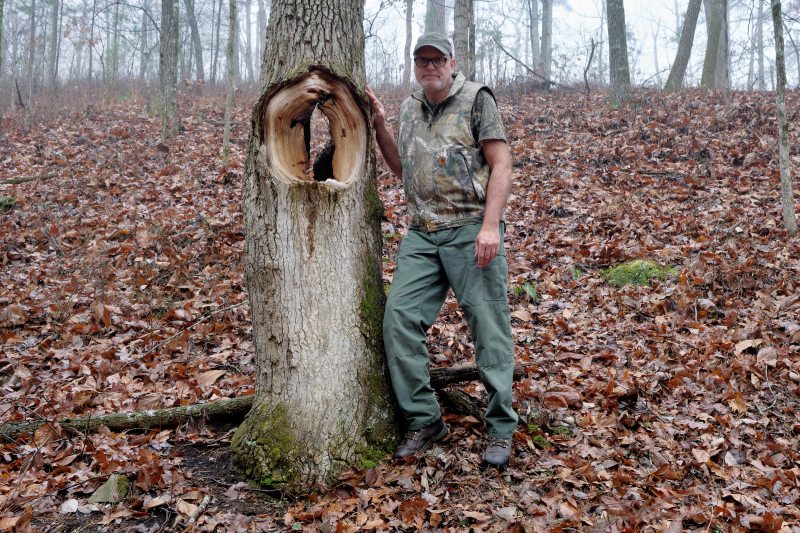During a December hike in Arkansas’s Ouachita National Forest, I came across a fascinating tree with a large hole in its trunk. Since I spend a lot of time hiking in this forest during the winter, I’ve seen all kinds of unusual trees, but this one made me wonder: why do trees sometimes have such big holes in their trunks? Learning the reasons can help us appreciate how forests work and how trees adapt to challenges. The answer comes from both natural and human causes, each leaving behind unique clues.

Natural Causes of Tree Trunk Holes
Hollowing Out
As trees get older, the wood in the middle of their trunks often dies and rots away. This creates a hollow space inside the tree, and sometimes that hollow reaches the surface, forming a hole. Signs of hollowing include:
- Smooth edges around the hole.
- No splinters sticking out.
- Bits of rotting wood inside or around the base of the tree.
For example, on one of my hikes, I saw a large oak tree with a round hole near its base. The smooth edges and bits of rotted wood scattered around showed it was hollowing out naturally—a sign of the tree’s aging process.
This is a normal part of how trees grow old, especially in forests where decomposing trees help enrich the environment.
Fungal Decay: How Fungi Create Holes in Tree Trunks
Fungi that break down wood are another common cause of tree holes. These fungi weaken the tree and eventually create cavities. Signs of fungal decay include:
- Mushrooms or other fungi growing on the trunk.
- Soft or discolored wood near the hole.
- Edges that are jagged or uneven.
Fungal decay often starts when the tree is injured, such as from a broken branch. While it can weaken a tree, fungi play an important role in the forest by breaking down old wood into nutrients that help other plants grow. They also provide homes for insects and other organisms.
Animal Activity: Wildlife and Tree Trunk Holes
Animals also create holes in trees. Birds like woodpeckers peck holes to build nests or find food. Signs of animal-made holes include:
- Peck marks around the hole.
- Bird droppings or feathers nearby.
Other animals, like squirrels, raccoons, or insects, may also create tree holes. You might see signs like nests, chewed wood, or scratch marks if animals are involved.
Other Possible Causes
Fire Damage
In areas prone to wildfires, flames can burn through tree trunks, leaving large holes. Signs of fire damage include:
- Burned or blackened wood.
- Fire scars on the bark.
- No signs of fungi or animals near the hole.
For example, in California’s Sierra Nevada forests, many trees have burned trunks with holes left by past wildfires. These trees show both the destruction and the recovery of the forest over time.
Human Intervention
Sometimes, people make holes in trees for different reasons, such as:
- Running cables or utility lines through them.
- Collecting sap.
- Carving signs or decorations.
These holes usually have smooth, even edges and might show tool marks. Unlike natural holes, they don’t typically have signs of fungi or animal activity around them.
Final Thoughts
Tree holes aren’t just random features—they tell the story of a tree and its environment. Whether made by nature, animals, or people, each hole reveals how trees and their surroundings are connected. The next time you’re hiking, stop and check out the trees around you. You might find a story hidden in their trunks! Share your discoveries and stories about tree holes to inspire others and deepen the conversation about these natural wonders. If you enjoy stories about nature and wildlife, you might also like this post about March’s wild start in nature.
